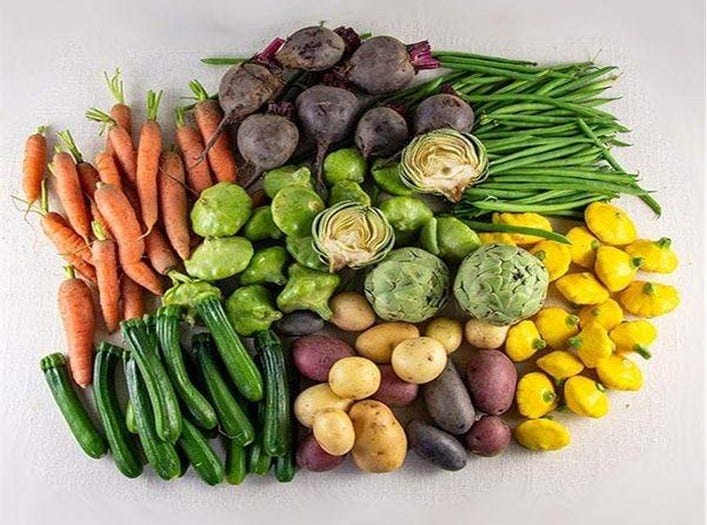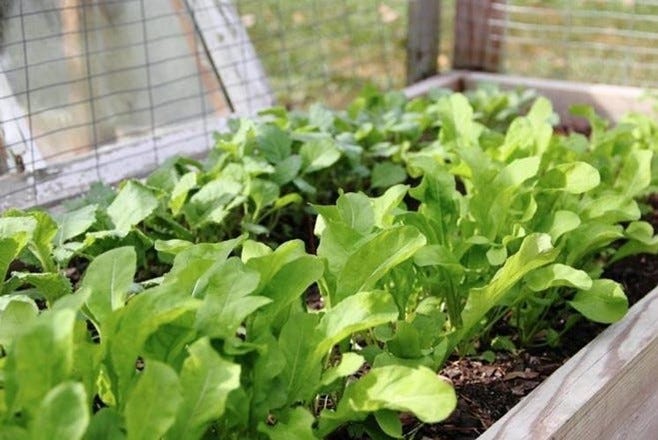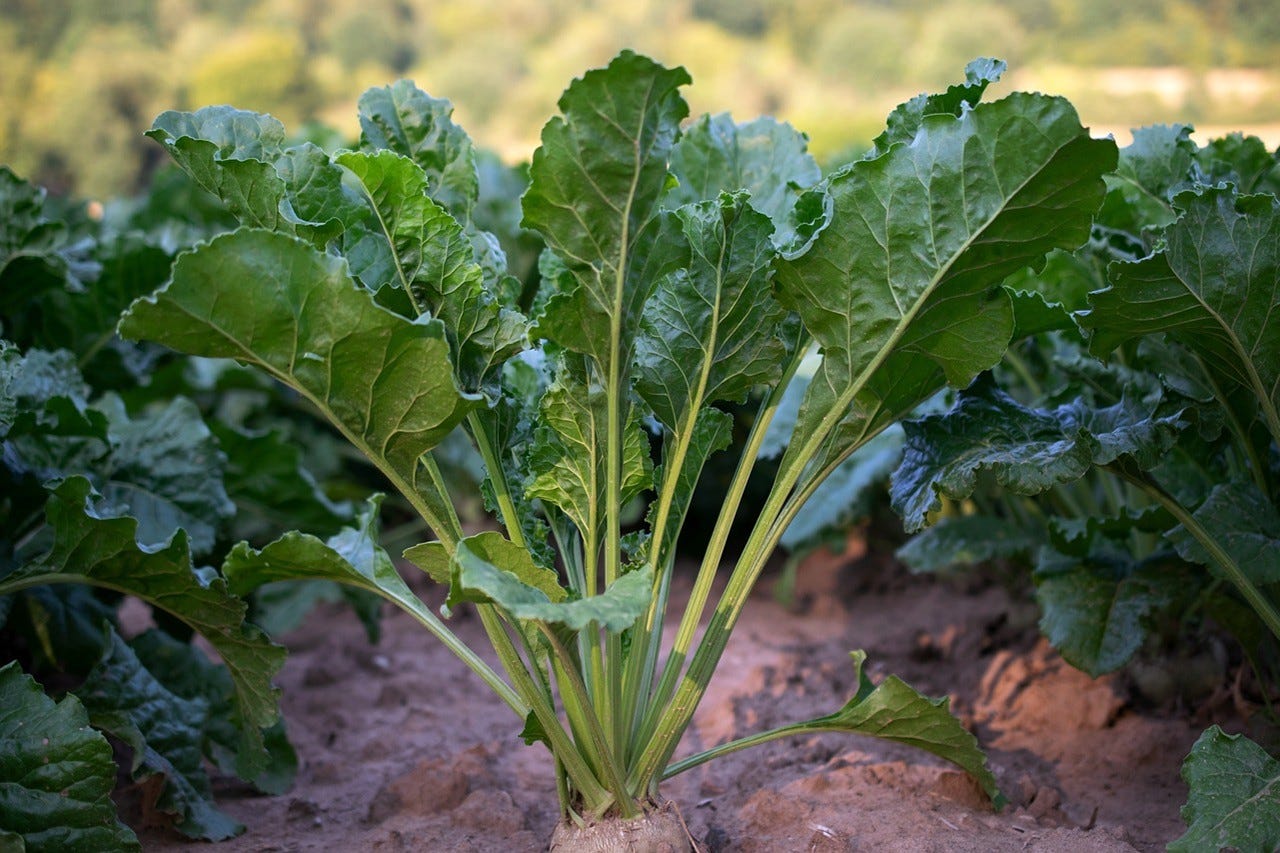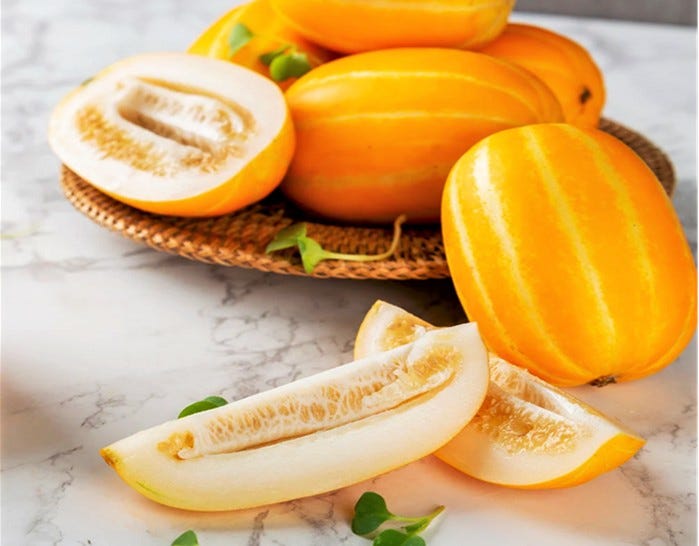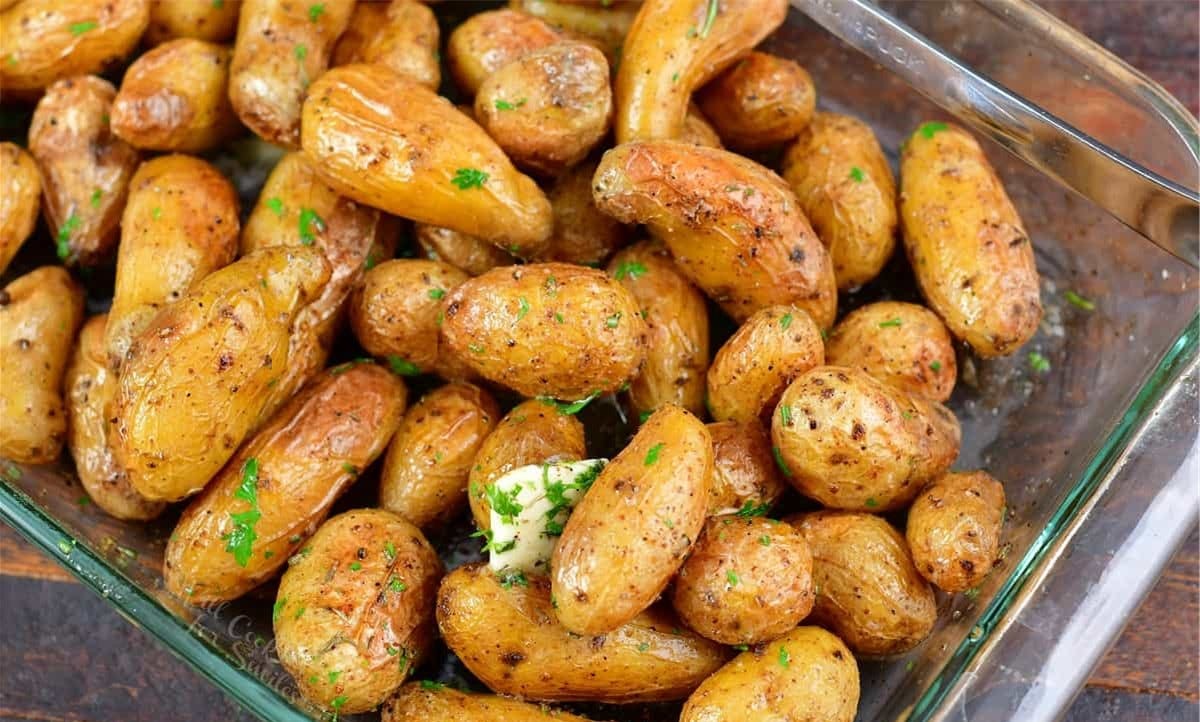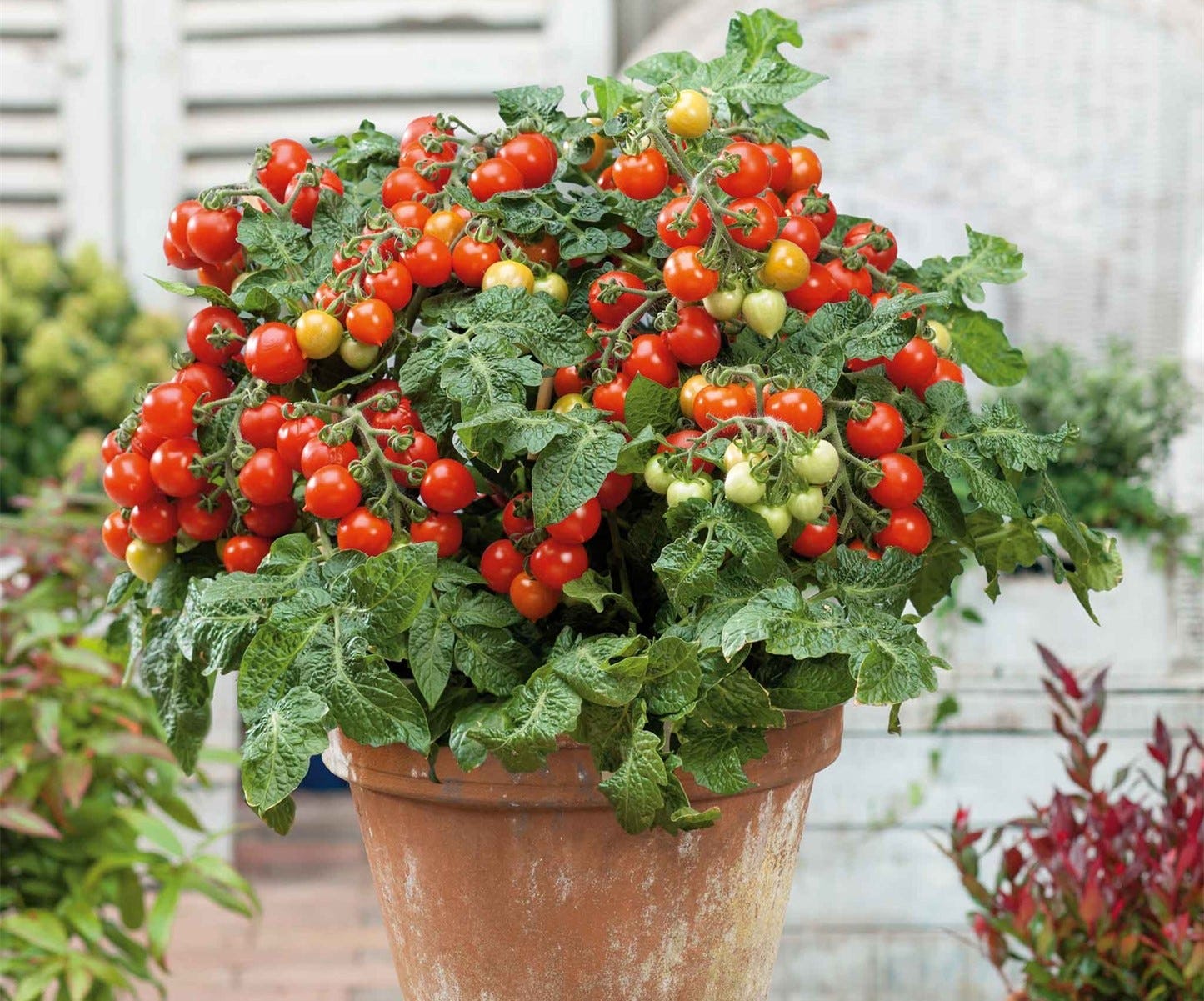THE JOY OF BABY VEGETABLES
Good for kids, impatient gardeners, swanky cooks, those with limited space, and those all-by-themselves individuals who just can’t get through a huge cabbage. Or just for fun.
The trend in baby vegetables has cycled; it’s come and gone, come and gone, etc. and (I think) it’s back again. Growing and eating tiny veggies were popular in the fifties, the sixties, and the eighty-nineties while a parallel universe of HUGE versions of those same vegetable types has always been there, in the background (every year, there’s news items for the 1000-pound pumpkin, the biggest cabbage, the ungodly-large onion, and the 5-pound-plus tomato). Most of that is contest or fairground level but inspired breeders are continually hybridizing and selecting for things like the next hefty (but tasty?) tomato. But the tiny guys have held strong and maybe it’s time to celebrate them again.
With so many more people taking to gardening and probably just as many taking to cooking, both in an effort to survive depressing economic figures, I’m confident the tiny stuff will find a new audience.
WHAT’S A REAL BABY VEGETABLE?
Pretty much everybody by now knows that so-called “baby carrots” sold in supermarkets aren’t “babies” at all. In fact, they’re broken carrots, misshapen carrots, or old big carrots (or is it “big ol’ carrots?”) that have been cut into two-inch pieces by one machine and then “polished” (they’re peeled and their edges are rounded off) by another machine. They’re certainly crunchier then real baby carrots but I’m not sure about the taste of most being any better (some new “baby” varieties have been bred for more sugar).
Natural baby vegetables, those straight from the ground and otherwise unadulterated, are the ones grown in some “tight” way, or harvested in an immature state, or they are genetic dwarf (“baby”) varieties of the plant type.
Not all vegetables can be grown as babies; but there are plenty that can be. Most annual root crops can be grown as baby veggies, including carrots, turnips, radishes, beets, potatoes, kohlrabi, onions, and more. Almost every kind of green will be more tender and more delicate in taste when harvested young. Even plants that are usually grown for their large heads — cabbage, radicchio, and heading lettuces — make great baby vegetables if grown in special ways.
WHY?
So what’s the “point” of growing and eating baby vegetables?
They make the most of a small space. That’s important to urban gardeners, to those who otherwise have a limited space, and even to those who have a large space but want to trial many types of vegetables.
Shorter root systems on many make them easier to grow in containers than full-sized vegetables and easier to grow more closely together. The shallow roots have taken their nutrients from maybe just the top four inches of soil. That means that even shallow soil systems – those that don’t have the deep, 12- to 18-inch or more layer of soil necessary for best yields, such as raised beds that are less than 12 inches deep or most container plantings or even in window boxes -- can still produce a proportionately good amount of nutritious food. Almost any vegetable will grow in a really large container; only special kinds will develop well in the smaller containers and, in fact, some become their “baby selves’ only when grown in small containers.
They’re cute and fun. Kids love ‘em and cooks can impress their guests with a modern plating.
Less volume of harvest per planting/sowing and that’s great for gardeners who don’t need a lot to eat at any one time and aren’t involved in or have limited resources to can, freeze, or dehydrate.
Most spend less time in the garden, which can maximize any space, hence larger yields in the long run. With greens and small roots, the returns are much quicker. You can have large amounts of baby greens for salads or roots stir-fries in just a couple of weeks. With some baby greens, you can leave a little leaf growth above ground and the plant will regrow quickly for repeat harvests.
Many are easier to grow than traditional varieties of a type. That’s certainly good for beginners.
Some are part of succession planting and that extends the season beyond conventional timing. Whereas a full-sized beet can take 60 to 90 days to mature, the same variety can be harvested as baby beets in about 40-50 days. Add to that and especially with genetically baby, early-maturing beets and a 120-day growing season, you could get three or four successions of baby crops instead of just two harvests of full-sized beets.
Growing smaller plants allows for trying more varieties; more flavors, more colors, more interest through the season.
Root vegetables, when harvested as adolescents, have tastier tops than the mature stuff has. These young greens aren’t tainted with the bitterness of being beaten down by hard days and nights, too many rains, etc.. You can use the tops of early harvests as greens, essentially doubling useable yields. (Why don’t more gardeners eat the greens of root veggies anyway?!)
Most taste pretty darn good, often sweeter and/or less bitter and certainly more tender, especially with those grown during the cool season(s).
Kitchen-wise, such small vegetables require little to no chopping, which makes for quicker cooking, quick snacking, and a higher caramelization-to-density ration when roasted (for those who like that kind of sweet-crispiness). Overall, they add gourmet appeal when plated up. Oh yeah, they definitely are super kid-friendly at the table (or before they even reach the kitchen).
What about nutritional content? Some are less nutritious than their larger counterparts, some more nutritious, and some equal. But considering some of the advantages regarding harvests, I propose that gardeners who grow baby vegetables in such a multitude of ways, will end up maximizing yields and eating the produce more and more efficiently.
IN THE GARDEN
Miniature vegetables come to us, as mentioned above, straight from the ground and otherwise unadulterated, in one of three ways:
They have been grown in some “tight” way (in pots, small raised beds, crowded within a row or space),
They have been harvested from usually large versions of a vegetable type but in an immature state, or
They are genetic dwarf (“baby”) varieties of the plant type.
If you intend to “crowd” them, make sure they are adapted to being grown in small-ish pots (under 5-gallon or 12-by-12) or small raised beds (less than 4-feet by 4-feet around and less than 12 inches deep). With larger containers, especially those that are well over 20- gallon size, your vegetable choices becomes, of course, much greater. As for crowding them (“planting closely”) in rows/areas of larger spaces, you’re limited to the naturally smaller plants such as almost all root and leaf vegetables.
For root and leaf crops that are to be harvested early, it’s best to select the fast growers, the ones capable of multiple harvests (such as beets, radishes, spinach, kales, and lettuces). These fast growers work well in succession sowing programs and with many of them ready to harvest within two to three weeks of sowing and can treated as a cut and come again crop, they can produce an almost continual supply of roots or leaves for two to three months (more if the season remains cool longer).
For fruiting crops such as beans, corn, eggplant, okra, peas, peppers, and squash, it also includes choosing the fast varieties, but just as important is selecting those with fruit that ripens quickly on the plant or ripens after harvest.
Genetically small vegetables (including fruits) are many. Check the extensive list in the next section “THE BABY VARITIES.”
Additional guidelines:
If growing in containers or troughs, make sure to use a soil mix that drains well.
You can sow leaf and root crops closely and either harvest altogether as mini-veggies or thin them out as they grow and use the thinned-out veggies as micro-greens (yes, root leaves are quite edible).
Succession sowing is sowing a batch of seeds on one date and then sowing a second batch in another row on another date (usually just two weeks later) and repeat until you’re no more than two weeks from debilitating summer heat (the kind of heat that pushes such vegetables to “bolt”).
Don’t let the soil dry out. Small vegetable plants of all kinds have shallow roots that dry out quickly. Daily watering may be necessary.
Feed plants in pots with a liquid fertilizer at half or quarter dose every couple of weeks.
Not all baby vegetables come from “baby” plants. Most “baby” fruits come from large plants;; give those space.
THE BABY VARIETIES
These are the varieties that make the “babies.” Most of these are genetically predisposed for a small size relatively to their type. Some are regular-sized varieties that are amenable to being minimized by various methods: (1) picked young, before their mature harvestable date; (2) sown or planting more closely; or (3) grown in a tight space such as containers.
Artichokes — Once outside leaves are peeled, the whole vegetable is edible; they have no fuzzy “choke.” There is no specific variety; it’s simply a matter of harvesting from the lowest side shoots of the flowering stems.
Beets — ‘Baby Ball’, ‘Boro’, ‘Detroit 2’, ‘Kestrel’, ‘Little Ball’, ‘Little Chicago’, ‘Pablo’, ‘Pronto Baby’, ‘Solo’, ‘Tardel’
Suitable methods: Succession sow for the cool season(s); Close planting; Good in containers
Bok Choy/Pak Choy — ‘Asian Delight’, ‘Bonsai’, ‘Dwarf Canton’, ‘Extra Dwarf Canton’, ‘Fun Jen’, ‘Mei Qing Choi’, ‘Petite Shanghai’, ‘Toy Choy’, ‘Wawa Qing’
Suitable methods: Succession sow for the cool season(s); Close planting; Good in containers
Brussels sprouts — ‘Catskill’, ‘Content’ (“Button Sprouts”), ‘Noisette’, ‘Tasty Nuggets’
Cabbage — ‘Baby Head’, ‘Catarina’, ‘Fast Cash’, ‘Orient Express’, ‘Picolima’, ‘Pixie’, ‘Primero’, ‘Samantha’, ‘Savoy Express’
Suitable methods: Close planting; Good in containers
Chinese Cabbage — ‘Bekamaru’, ‘Caraflex’, ‘Fong San’, ‘Green Seoul’, ‘Mini Kisaku’, ‘Mini Napa’, ‘Minuet’, Nanjin’, ‘Reaction’, ‘Storage No. 4’, ‘Yukina Savoy’, ‘Wa Wa Sai’
Suitable method: Close planting; some good in containers.
Carrots (the REAL “baby” carrots”) — ‘Adelaide’, ‘Amini’, ‘Amsterdam 2 Maxi’, ‘Baby Babette’, ‘Baby Finger’, ‘Baby Sweet’, ‘Caracas’ ‘Little Finger’, ‘Minicor’, ‘Nelson’, ‘Oxheart’, ‘Parisian’ (‘Parisienne’), ‘Parmex’, ‘Sugarsnax 54’, ‘Thumbelina’, ‘Tonda di Parigi’
Suitable methods: Succession sow for the cool season(s); Close planting; Good in containers
Cauliflower — ‘Florentino’, ‘Freedom’, ‘Idol’, ‘Silver Cup’, ‘Snow Crown’, ‘Sunset’, ‘Veronica’ (Romanesco)
Corn — Baby corn (the kind served in Chinese restaurants or found in jars of pickled mixed vegetables) comes from dense planting and early harvest. Best variety for such methods: ‘Bonus’
Corn, popping — ‘Baby White’, ‘Japanese Hulless’, ‘Mini Blue’, ‘Mini Pink’, ‘Minipop’
Cucumber — ‘Ayda’, ‘Dragon’s Egg’, ‘Fresh Delight’, ‘Gherking’ (gherkin type), ‘Green Fingers’ (Persian), ‘Hana’, ‘Katrina’, ‘Lunchbox’, ‘Mini-Me’, ‘Muncher’ (Persian), ‘Parakeet’, ‘Parisienne Cornichon de Bourbonne’ (gherkin type), ‘Party Time’, ‘Passandra’, ‘Petita’, ‘Pick a Bushel’, ‘Quick Snack’
For container: ‘Arkansas Little Leaf’, ‘Excelsior’, ‘Midget Bush Pickling’, ‘Mini Munch’, ‘Patio Snacker’, ‘Picolino’
Eggplant — ‘Baby Belle, ‘Black Baby’;, ‘Calliope’, ‘Chu Chu’, ‘Kermit’, ‘Little Fingers’, ‘Petch Siam’, ‘Shooting Stars’, ‘Snowy’, ‘Thai Green Pea’, “Thai Round” (several), ‘Thai Yellow Egg’, ‘Twinkle’ (teardrop-like)
For container: ‘Hansel’, ‘Gretel’, ‘Little Prince’, ‘Patio Baby’
Fennel — ‘Finale’, ‘Fino’, ‘Orazio’, ‘Perfection’, ‘Preludio’, ‘Rondo’, ‘Selma’
Suitable methods: Succession sow for the cool season(s); Close planting; Harvest early
Greens, Miscellaneous — Harvesting when small to very small: micro-mini-greens (the “thinnings” of seedlings), mini-greens (fairly leafy), and baby greens (around half the size of expected maturity). Mixed salad leaves can be sown as mixed seeds (“mesclun”) or varieties/types sown separately and mixed in the kitchen. Some are cut-and-come-again.
Suitable methods: Succession sow for the cool season(s); Close planting; Good in containers
Green beans (haricot verts, the skinny French bean) — ‘Aigullon’, ‘Alicante’, ‘Baguette’ (bush), ‘Caruso’, ‘Delinel’ (bush), ‘Emerite’, ‘Fin de Bagnols’, ‘Finaud’, ‘Marbel,’ ‘Maxibel’, ‘Montpelier’ (bush), ‘Morgane’, ‘Nickel’, ‘The Prince’, ‘Rolande’ (bush), ‘Soleil’ (bush, yellow), ‘Straight n’ Narrow’ (bush), ‘Tavera’ (bush), ‘Triumph de Farcy’, ‘Velour’, ‘Vernandon’
Suitable methods: Succession sow beginning at the early part of the warm season; Early harvest
Green Onion — Almost any variety. Harvest young
Suitable methods: Succession sow for the cool season(s); Close planting; Good in containers
Kale — ‘Dwarf Blue’, ‘Red Russian’, ‘Starbor’, ‘Tuscan Baby Leaf’
Suitable methods: Succession sow for the cool season(s); Close planting; Good in containers
Leeks — ‘Albinstar’, ‘Baby Primor’ ‘King Richard’, ‘Imperial Summer’, ‘Zermatt’
Suitable methods: Close planting; Good in containers
Lettuce — As baby greens (see above, under “Greens, Miscellaneous”)
Suitable methods: Succession sow for the cool season(s); Close planting; Good in containers
Melons — ‘Alvaro’ (Charentais), ‘Arava’ (hybrid melon), ‘Early Silver Line’ (Asian), ‘Kazakh’ (Asian), ‘Lil Sweet’ ‘Minnesota Midget’ (Muskmelon [“Cantaloupe”]), ‘Mirza’ (‘Torpedo’, Asian),‘Orange Silver Wave’ (Asian), “Oriental Melon” (Korean Melon, Golden Melon, Chamoe), ‘Sprite’ (Asian), ‘Sugar Cube’ (Muskmelon [“Cantaloupe”]), ‘Tasty Bites’ (Charentais), ‘Tigger’ (Asian), “Vine Peach” (“Mango Melon,” Asian)
For containers, small spaces (Bush melons): ‘Golden Jenny’ (Muskmelon [“Cantaloupe”]), ‘Honey Bun’ ‘Minnesota Midget’ (Muskmelon [“Cantaloupe”]), ‘Minnesota Midget’ (Muskmelon [“Cantaloupe”]), ‘Sleeping Beauty’
Okra — For Containers: ‘Baby Bubba’, ‘Little Lucy’
Onion — Pearl onions: ‘Barletta’ (‘White Pearl’),’Crystal Wax’, ‘de Paris’ (‘Silverskin’), ‘Eclipse, ‘White Mexican’ (‘El Toro’)
Cippolini (Italian flat onions): ‘Borettana’ (“of Parma”), ‘Gold Princess’, ‘Piatta Di Bergamo’
Peppers, Bell — ‘Jingle Bells’, ‘Miniature Chocolate’, ‘Miniature Red Belle’, ‘Snackabell’, ‘Sprinter’
For containers: ‘Apache’, ‘Cute Stuff Red’, ‘Cute Stuff Gold’, ‘Golden Baby Bell’, ‘Mohican’ ‘Redskin’
Peppers, Other small sweet types for containers: ‘Confetti’, ‘Red Popper’, ‘Sweet Pickle’, ‘Sweet Snack’, ‘Yummy’, ‘Yum Yums’
Petite Pois (peas) — ‘Fabina’, ‘French Citadel’, ‘Frizette’, ‘Petit Provencal’ (heirloom), ‘Precovil’, ‘Proval’, ‘Waverex’
Suitable methods: Succession sow for the cool season(s)
Potatoes — For small “new” potatoes: ‘Adirondack Blue’, ‘Ama Rosa’, ‘Arizona Gold’, ‘Charlotte’, ‘Dark Red Norland’, ‘Huckleberry Gold’, ‘Red Pontiac’, ‘Sangre’, ‘Yukon Gold’
Fingerlings: ‘Austrian Crescent’, ‘Bellanita’, ‘Butterfinger’ (‘Peanut’), ‘Cecile’, ‘French Fingerling’, ‘German Finger,’ ‘Magic Molly’, ‘Makah Ozette’, ‘Noelle’, ‘Purple Magic’, ‘Purple Peruvian’, ‘Rose Finn Apple’, ‘Russian Banana’, ‘Swedish Finger’
Suitable methods: Good in containers
Pumpkin — ‘Baby Boo’, ‘Baby Pam’, ‘Sugar Pie’, ‘Wee-Be-Little’
There are tinier pumpkins than these but they are strictly ornamental.
Radishes — ‘Cherry Belle’, ‘D’Avignon’, ‘Easter Egg’, ‘Hailstone’, ‘White Beauty’
Suitable methods: Succession sow for the cool season(s); Close planting; Good in containers
Spinach — most popular for “baby:” ‘Bloomsdale Longstanding’, ‘Carmel’, ‘Regiment’
Almost any spinach can be grown and harvested as “baby spinach” if grown according to these “Suitable methods:” Succession sow for the cool season(s); Close planting; Good in containers
Squash, Summer — Most, harvested early, with or without flowers, especially: Patty pan/Scalloped/Scallopini (esp. ‘Sunburst’), Crooknecks, Yellow Straightnecks (esp. ‘Butterstick’), Zucchini (esp. ‘Bambino’, ‘Condor,’ ‘Patriot’)
For containers: ‘Astia’, ‘Bossa Nova’, ‘Bush Baby’, ‘Patio Star’
Suitable methods: Harvest early; Grow (some varieties) on trellis
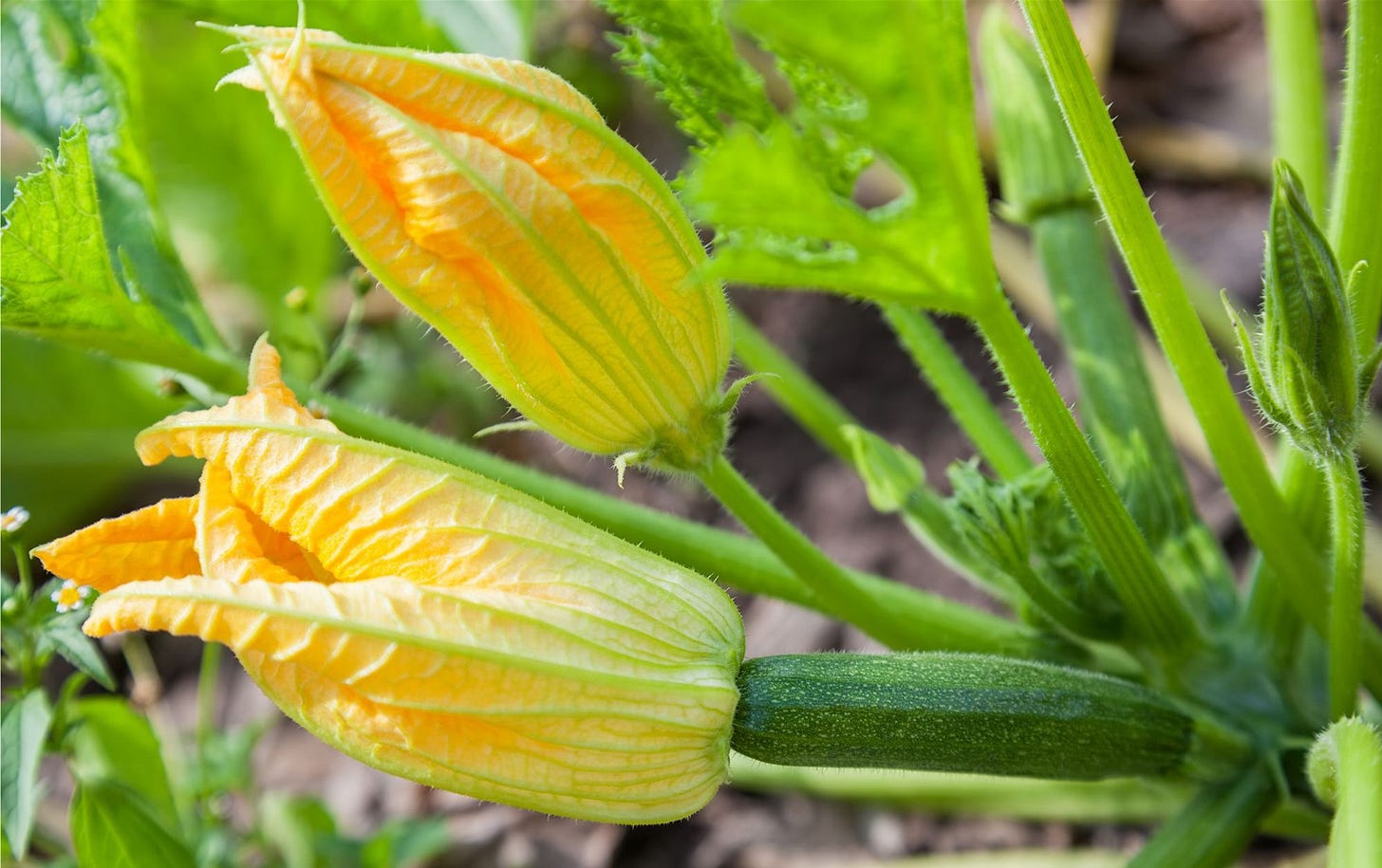
Squash, Autumn/Winter — Harvested as “summer squash”: almost any “Acorn” type (esp. ‘Table Queen’).
Small at maturity: ‘Baby Honeynut’ (Butternut), ‘Baby Spaghetti’, ‘Barbara’ (Butternut), ‘Small Wonder’ (Spaghetti), ‘Sweet Dumpling’ (Delicata hybrid)
Tomatoes — There are plenty of small-fruited tomato types and varieties – the cherries, currants, “spoons,” grapes (tear-drops), etc., but nobody really calls them “baby tomatoes.” So I’m not going to list the many hundreds of varieties of these tiny-fruited summer snacks. But I will list the varieties, mostly small-fruited, within a special-use sub-category…
For small containers (almost every tomato variety will grow in a really big container; these are the most dwarf/compact of the lot): ‘Black Magic’, ‘Franklin County’, ‘Goldfinch’, ‘Gourmandise Yellow’, ‘Heartbreaker’, ‘Husky Red’, ‘Inca Jewels’, ‘Jolly Elf,’ ‘Kootenai’, ‘Litt’l Bites’, ‘Micro Gemma’, ‘Micro Tina’, ‘Micro Tom’ (the tiniest of all), ‘Mini Charm,’ ‘Patio Princess’, ‘Saucy Mary’, ‘Super Bush’, ‘Sweet Baby Girl’, ‘Terenzo’, ‘Tidy Treats’, ‘Totem’, ‘Veranda Red’, ‘Window Box Roma’, ‘Yellow Canary’
Even for hanging baskets: ‘Cherry Blast’, ‘Cherry Cascade’, ‘Cherry Falls’, ‘Donna Red’, ‘Floragold Basket’, ‘Garden Pearl’, ‘Hundreds and Thousands’, (‘Little Birdy) ‘Red Robin’, ‘Lizzano’, ‘Patio Choice Yellow’, ‘Pearl Drops’ (paste), ‘Rambling Rose’, ‘Tiny Tim’, ‘Tumbler,’ ‘Tumblin’ Tom Red’, ‘Tumblin’ Tom Yellow, ‘Whippersnapper’
Turnip — ‘Atlantic’, ‘de Milan Rouge’, ‘Hakurei’, ‘Mikado’, ‘Shogoin’, ‘Snowball’ (‘Tokyo’), ‘White Egg’
Suitable methods: Harvest early; Plant closely
Watermelon — ‘Golden Midget’, ‘Little Baby Flower’, ‘Little Darling’, ‘Mini Me’, ‘Mini Piccolo’, ‘Yellow Baby’, ‘Yellow Doll’, ‘Yellow Petite’
Bush types (small space): ‘Jubilee’, ‘Sugar Baby’
IN THE KITCHEN
What can you do with baby vegetables?
The techniques:
Fresh, raw (maybe peeled)
Blanched (quick “boil”)
Braised
Glazing (generally at the end of or even after another method of cooking)
Grilled (on skewers or “pan-grilled”)
Marinating (cold, after cooking by another method)
Microwave (not in my house but others do it)
Pickled
Poached (a simmer, not a “boil”)
Roasted
Sauteed
Steamed
Stir-fried
[pretty much any way]
The gourmet approach: “soft-cooked” and “crisp-tender” (leave the “freshness” in them) involving a quick blanch/par-cook and then finished by sautéing or stir-frying.

The places:
Crudites (appetizers)
Casseroles
Oven roasts
Pastas
Pot roasts
Risotto
Salads
Soups (chunky)
Stews
and, of course, Sides
© Copyright Joe Seals, 2025




